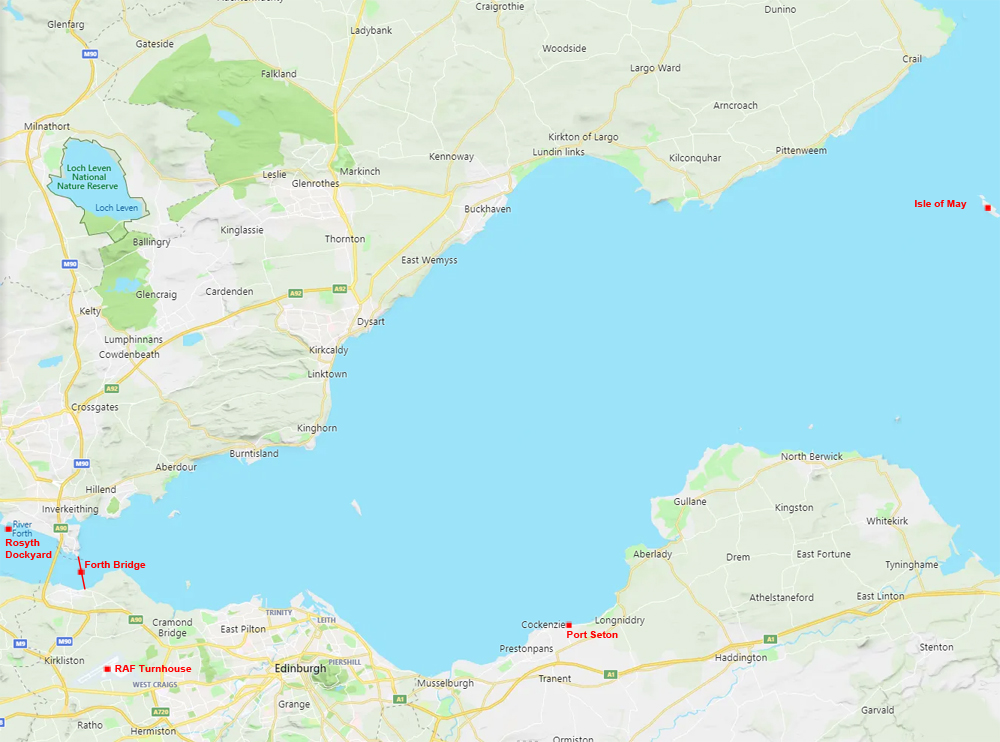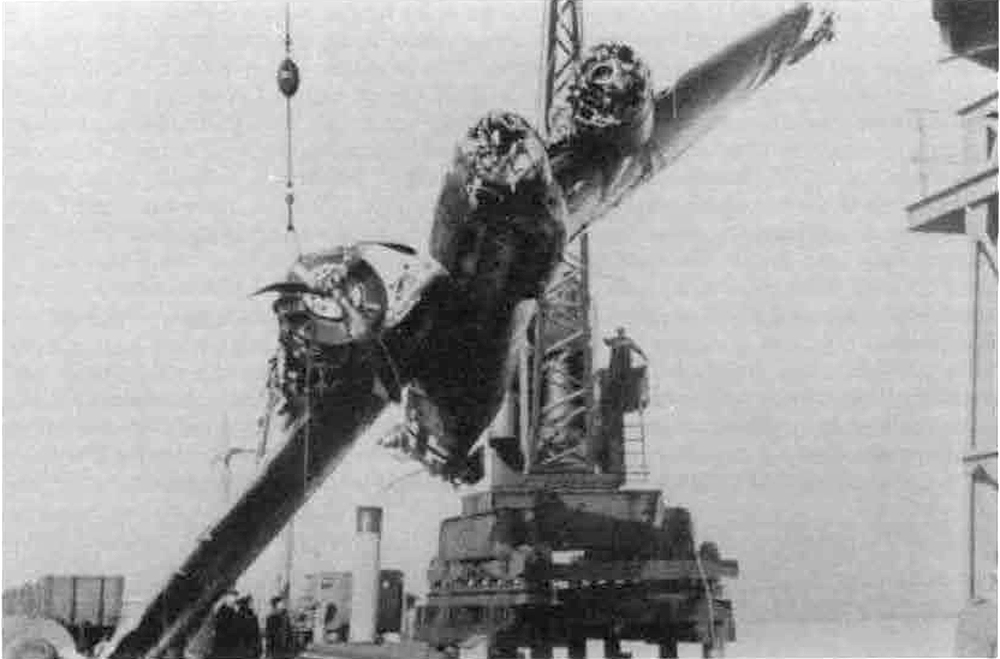First Air Raid of WWII – 28
14:45 – The end of Storp
| < 27 Pursuit over Hillend | Δ Index | 29 Pohle intercepted > |
John Donaldson, who had earlier witnessed Pohle’s section flying towards the Forth Bridge witnessed a number of Ju88s being pursued cast over the Forth and the end of Storp’s part in the war.

The bombers were being hotly pursued by Spitfires, low-flying and blasting away with machine guns. I had an excellent view of the one shot down into the sea off Port Seton. Another flew over our head making for the hills with spent bullets hitting the shed behind us.
John Dickson, of Links Road. Port Seton, was the skipper of the 35-foot yawl Dayspring, which was used for line fishing. At 04.00 hours on the morning of the 16th the Dayspring left port on the two and a half hour journey to May Island where John and his crew would shoot lines. In such a small vessel a trip so far offshore was an adventurous one and took courage and years of experience. On board with John were his sons William and John (junior) and brothers Andrew and Sandy Harkness.
As John headed back to Port Seton he and the lads were initially quite unaware that an air raid was in progress when the Ju88 of Hans Storp came into view pursued by the Spitfires of Patsy, Robbie and Ken, with Red 1 in the process of delivering his final attack. The crew of the Dayspring looked on as the Luftwaffe bomber flew out over the river with smoke trailing from one engine. Approximately four miles offshore from Port Seton the elevator failed and the nose of Ju88 Dora-Heinrich reared up before it dived into the waters of the Forth in a great white splash. The time was 14.45 hours.
John Dickson estimated that the aircraft flew over the Forth at approximately 100 feet with undercarriage lowered and hit the water about a mile from his vessel. His son, John, called out: ‘You’d better go and see if they’re alive.’ He later recalled his father “. . . was not keen as he thought they might have guns and could attempt to take the boat to Germany.’ His brother, William, was harder and thought that as they might have bombed Edinburgh and killed innocent civilians they should just leave them.
Nevertheless. John Dickson set course at full speed to render assistance. It took the Dayspring half an hour to cover the distance and the crew noticed that the Junkers remained afloat for about five minutes and, while the fishing boat was still a considerable distance away, it slipped beneath the surface.
As they neared the site, any apprehension regarding the possibility of attack and hijacking of the boat by the German airmen had gone but as John (senior) could see no sign of survivors in the water he believed they must have gone down with the aircraft and that his efforts had been in vain.
However, as he drew closer be spotted three survivors clinging to an air-filled float and a rope was thrown out to them. Whilst two of the Germans swam towards the Dayspring, the third was so reluctant to release his grip from the float, out of desperation he grasped the rope between his teeth and was hauled in. All three were relieved to be pulled shivering and exhausted from the icy waters of the Forth.
The skipper saw that one of the Germans was wearing an Iron Cross (Storp) and had a cut on his face. As the three airmen sat on deck he noticed the others had similar injuries.
John Dickson and the lads provided food, cigarettes and thick dry jumpers to put on over the Germans’ wet flying clothing. In response they expressed their gratitude by vigorously shaking the hand of every crew member who were by now aware they were not in the least bit hostile or aggressive. They considered themselves lucky to be alive and informed them that the fourth member of their crew had gone down with the aeroplane.
[Newsreel showing Storp’s capture was later shown in a cinema in Stockholm in neutral Sweden. It was seen by a friend of Storp who sent a cable to his family in Germany informing them that he was alive, whilst they had assumed he had been killed.]
A small number of local people had already started to gather as the Dayspring pulled alongside in Port Seton harbour. All three survivors managed to walk unaided up the harbour steps, half an hour after they had been rescued.
On arrival Storp told a German speaking local that: ‘we had no chance to get away … our plane was just too slow’.
Although none of the airmen was seriously injured, each had sustained cuts and bruises and was suffering from hypothermia, and Hielscher had received a blow to the ribs and was subsequently put on a stretcher. According to John Dickson (junior): ·All three men were very grateful for being rescued, and the leader, who spoke English fairly well, took a heavy gold signet ring with the German eagle on from his finger and gave it to my father.’ The fisherman duly accepted the gift. John junior still wears the ring today.
The following day divers went down to try to find the wreckage of Storp’s aircraft. They located it in about 100 feet of water, attached lifting gear and the aircraft was raised.

Despite the salvage operation the body of the gunner was never found. Storp later confirmed that he had been killed during the first attack by (Black Morton’s) Spitfire. The cold waters of the Forth became the grave for Obergefreiter Kramer.
All three were taken to Cockenzie Police Station, situated in Port Seton, where local GP Dr. Black administered first aid. PC Henry ‘Harry’ Stevenson was on duty at the time and some years later his daughter Barbara, then a schoolgirl, recalled:
.. my father was too busy trying to balance his Fine Book (local people who had been fined at the Burgh Court paid their fines at the Station) and did not take too much notice of the air activity overhead. By the time I arrived home from school, chaos reigned. I think the whole population of the Burgh had gathered at the Police Station as news had travelled fast that Germans had been brought in to the harbour on a fishing boat and were in the Police Station. There were no instructions in the Police Manual for dealing with this type of incident!
Calls went out for dry clothing for the airmen, but one lady suggested a clothes rope might be more appropriate! The local publican sent a bottle of brandy round to the Police Station and I recall my father saying the airmen greatly appreciated that. Military Intelligence Officers arrived and the prisoners were taken by ambulance to Edinburgh Castle, taking with them our hot water bottles to help keep them warm. Alec Craig had provided some clothing for one of the airmen and when it was returned there was an Iron Cross in the jacket pocket. Although he was tempted to keep it, he thought it best to return it to the prisoner.
On the evening of the 16th. Flight Lieutenant Gifford arrived at the Police Station to have a word about the day’s events … while my mother made the visitor a cup of tea, I went out to try and find them – no personal radios in those days! We duly located them and they returned to the office and talked over the day’s events. I thought Flight Lieutenant Gifford was terribly handsome and from then on my ambition was to join the WAAF!
It is interesting to compare the friendly and supportive assistance given by the residents of the Burgh of Cockenzie and Port Seton at a time when the attacks by the Luftwaffe on our cities had yet to begin, with the reaction of the British public to downed German aircrew as the war progressed. An excellent example of the change being the experience of 603’s own Sheep Gilroy in August 1940.
The three Germans were taken under escort from Cockenzie Police Station to the military hospital at Edinburgh Castle, which had been partially transformed earlier that year into a small hospital for military personnel for minor operations, accidental injury caused during training and convalescence and were beset by many questions both official and unofficial. However, they must have welcomed the relief of being able to climb between the dry sheds of their hospital beds, but even then they were not left alone.
Despite a guard on the door a couple of press photographers managed to get into the room. Having taken their photographs they were about to leave when the garrison commander arrived on the scene and all hell broke loose. The photographers were escorted from the castle as the guards faced a severe reprimand. The photograph was indeed a coup, the first to be taken of Luftwaffe prisoners of war during WWII.
[Today the National War Museum of Scotland occupies what was the wartime military hospital in Edinburgh Castle, in particular the NWM archive occupies one of the wards.]
By that time, Pohle, the Gruppenkommandeur of KG30 was also a prisoner, aboard HMS Jervis with two of his crew dead and a third fatally wounded. Storp later met Pohle again whilst in captivity in Canada. He commented:
That the Spitfire pilots shot down only two machines was not the fault of the Spitfire pilots, but because of the late warning they received. Spitfire group pilots visited us the same day in hospital, bringing cigarettes and chocolate. We thought this very fair, and have not forgotten this to this day.
The senior army officer in charge at the castle at the time visited Storp on the ward. Two of the three aircrew were busy thumbing through the pocket size editions of the English dictionary thoughtfully given to them by their captors. Having introduced the prisoner to his companions as Hans Storp, he asked him if he was being well treated: ‘Yes, thank you sir,’ Storp replied in perfect, well enunciated, English.
Lurid details of supposed injuries to the Luftwaffe crew were published in the national and, in particular, local newspapers, but apart from 27-year-old Hielscher the only other injuries consisted of cuts and bruises. With so much ammunition having been expended in their direction, the three survivors had been very lucky.
| < 27 Pursuit over Hillend | Δ Index | 29 Pohle intercepted > |
top of page
